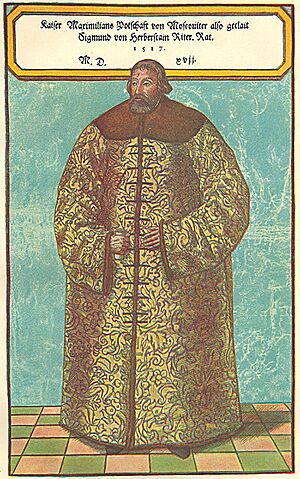Sigismund von Herberstein facts for kids
Siegmund von Herberstein (born August 23, 1486 – died March 28, 1566) was an important diplomat, writer, and historian. He came from a place called Carniola, which is now part of Slovenia. He was also a member of the Imperial Council of the Holy Roman Empire, a large group of states in Central Europe. Herberstein is most famous for his detailed writings about Russia. His books described Russia's geography, history, and the way its people lived. His work greatly helped people in Western Europe learn about this distant country.
Contents
Siegmund von Herberstein: Explorer and Diplomat
His Early Life and Education
Siegmund von Herberstein was born in 1486 in a town called Vipava, located in what is now Slovenia. At that time, this area was part of the Habsburg monarchy. His parents, Leonhard and Barbara von Herberstein, belonged to a well-known German-speaking family. This family had lived in Herberstein Castle for almost 200 years. Not much is known about his early childhood, but he did learn the Slovene language spoken in his region. This skill became very useful later in his life.
In 1499, Siegmund went to the University of Vienna to study philosophy and law. After finishing his studies, he joined the army in 1506 as an officer. He fought in several military campaigns. In 1508, the Holy Roman Emperor, Maximilian I, personally made him a knight. This was a great honor. In 1515, he joined the Imperial Council, which was like a parliament. This marked the beginning of his long and successful career as a diplomat.
A Diplomat's Journeys
Between 1515 and 1553, Herberstein went on about 69 missions to other countries. He traveled across much of Europe, even visiting Turkey. The ruling Habsburg family, who were very powerful, honored him with special titles and land.
He was sent to Russia twice as an ambassador for the Holy Roman Emperor. An ambassador is a person who represents their country in another country. His first trip was in 1517. He tried to arrange a truce, or a stop to fighting, between Russia and Lithuania. His second trip was in 1526 to renew a peace treaty that had been signed in 1522. These visits were quite long; for example, his 1517 trip lasted nine months. These extended stays gave him a special chance to study Russian society, which was largely unknown to people in Western Europe at the time.
Learning About Russia
Herberstein's knowledge of the Slovene language, which he learned as a child, was very helpful. Slovene and Russian are both Slavic languages, meaning they are similar enough for speakers to understand each other. He used this ability to talk to many different people in Russia about various topics. This gave him a much deeper understanding of Russia and its people than previous visitors had.
He probably wrote his first report about life in Russia between 1517 and 1527. However, no copies of this early report still exist. In 1526, he was asked to write a formal report about his experiences in Russia. This report stayed mostly hidden in official records until he had time to work on it more. He likely started revising and adding to it in the 1530s.
Herberstein was a very energetic and skilled ethnographer. An ethnographer is someone who studies different cultures and peoples. He learned a lot by asking local people questions and by carefully reading the few books that existed about Russia. The result of his hard work was his most important book, written in Latin. It was called Rerum Moscoviticarum Commentarii, which means "Notes on Muscovite Affairs." This book was published in 1549. It quickly became the main source of information about Russia for people in Western Europe.
Herberstein was also the first person to write the word tsar as czar. Both spellings mean the same thing and are pronounced similarly. Later, in the 1800s, English and French languages started using the 'ts' spelling more often instead of 'cz'.



